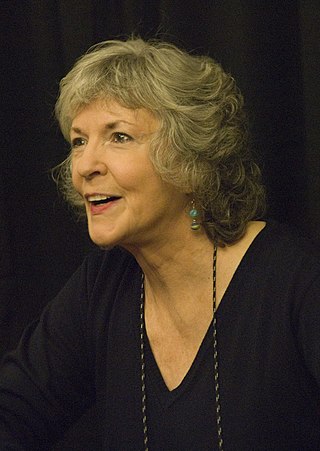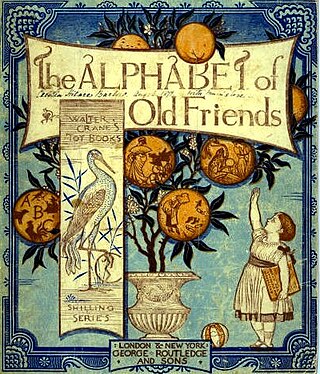
Gematria is the practice of assigning a numerical value to a name, word or phrase by reading it as a number, or sometimes by using an alphanumerical cipher. The letters of the alphabets involved have standard numerical values, but a word can yield several values if a cipher is used.
The Hebrew alphabet, known variously by scholars as the Ktav Ashuri, Jewish script, square script and block script, is traditionally an abjad script used in the writing of the Hebrew language and other Jewish languages, most notably Yiddish, Ladino, Judeo-Arabic, and Judeo-Persian. In modern Hebrew, vowels are increasingly introduced. It is also used informally in Israel to write Levantine Arabic, especially among Druze. It is an offshoot of the Imperial Aramaic alphabet, which flourished during the Achaemenid Empire and which itself derives from the Phoenician alphabet.

A nursery rhyme is a traditional poem or song for children in Britain and many other countries, but usage of the term dates only from the late 18th/early 19th century. The term Mother Goose rhymes is interchangeable with nursery rhymes.

Tifinagh is a script used to write the Berber languages. Tifinagh is descended from the ancient Libyco-Berber alphabet. The traditional Tifinagh, sometimes called Tuareg Tifinagh, is still favored by the Tuareg Berbers of the Sahara desert in southern Algeria, northeastern Mali, northern Niger and northern Burkina Faso for writing the Tuareg Berber language. Neo-Tifinagh is an alphabet developed by Berber Academy to adopt Tuareg Tifinagh for use with Kabyle; it has been since modified for use across North Africa.

Children's literature or juvenile literature includes stories, books, magazines, and poems that are created for children. Modern children's literature is classified in two different ways: genre or the intended age of the reader, from picture books for the very young to young adult fiction.

Catherine Greenaway was an English Victorian artist and writer, known for her children's book illustrations. She received her education in graphic design and art between 1858 and 1871 from the Finsbury School of Art, the South Kensington School of Art, the Heatherley School of Art, and the Slade School of Fine Art. She began her career designing for the burgeoning holiday card market, producing Christmas and Valentine's cards. In 1879 wood-block engraver and printer, Edmund Evans, printed Under the Window, an instant best-seller, which established her reputation. Her collaboration with Evans continued throughout the 1880s and 1890s.
The Initial Teaching Alphabet is a variant of the Latin alphabet developed by Sir James Pitman in the early 1960s. It was not intended to be a strictly phonetic transcription of English sounds, or a spelling reform for English as such, but instead a practical simplified writing system which could be used to teach English-speaking children to read more easily than can be done with traditional orthography. After children had learned to read using I.T.A., they would then eventually move on to learn standard English spelling. Although it achieved a certain degree of popularity in the 1960s, it has fallen out of use.

Sue Taylor Grafton was an American author of detective novels. She is best known as the author of the "alphabet series" featuring private investigator Kinsey Millhone in the fictional city of Santa Teresa, California. The daughter of detective novelist C. W. Grafton, she said the strongest influence on her crime novels was author Ross Macdonald. Before her success with this series, she wrote screenplays for television movies.

A chapbook is a small publication of up to about 40 pages, sometimes bound with a saddle stitch.
A children's song may be a nursery rhyme set to music, a song that children invent and share among themselves or a modern creation intended for entertainment, use in the home or education. Although children's songs have been recorded and studied in some cultures more than others, they appear to be universal in human society.
Iona Margaret Balfour Opie, and Peter Mason Opie were an English married team of folklorists who applied modern techniques to understanding children's literature and play, in studies such as The Oxford Dictionary of Nursery Rhymes (1951) and The Lore and Language of Schoolchildren (1959). They were also noted anthologists, assembled large collections of children's literature, toys, and games and were regarded as world-famous authorities on children's lore and customs.

The Gashlycrumb Tinies: or, After the Outing is an alphabet book written by Edward Gorey that was first published in 1963 as the first of a collection of short stories called The Vinegar Works, the eleventh work by Gorey. The book tells the tale of 26 children and their untimely deaths. It is one of Edward Gorey's best-known books and is the most notorious amongst his roughly half-dozen mock alphabets. It has been described as a "sarcastic rebellion against a view of childhood that is sunny, idyllic, and instructive". The morbid humor of the book comes in part from the mundane ways in which the children in the story die, such as falling down the stairs or choking on a peach. Far from illustrating the dramatic and fantastical childhood nightmares, these scenarios instead poke fun at the banal paranoias that come as a part of parenting.

Street cries are the short lyrical calls of merchants hawking their products and services in open-air markets. The custom of hawking led many vendors to create custom melodic phrases to attract attention. At a time when a large proportion of the population were illiterate, the cries of street vendors and town criers provided the public with important messages, whether those messages were commercial in nature or of more general public interest. Street Cries were part of the aural fabric of street life from antiquity.

An alphabet book is a type of children's book giving basic instruction in an alphabet. Intended for young children, alphabet books commonly use pictures, simple language and alliteration to aid language learning. Alphabet books are published in several languages, and some distinguish the capitals and lower case letters in a given alphabet.

Edmund Evans was an English wood-engraver and colour printer during the Victorian era. He specialized in full-colour printing, a technique which, in part because of his work, became popular in the mid-19th century. He employed and collaborated with illustrators such as Walter Crane, Randolph Caldecott, Kate Greenaway and Richard Doyle to produce what are now considered to be classic children's books. Little is known about his life, although he wrote a short autobiography before his death in 1905 in which he described his life as a printer in Victorian London.

Little Eva: The Flower of the South is an Anti-Tom children's book by American writer Philip J. Cozans. Although its publication date is unknown, scholars estimated the release was either in the 1850s or early 1860s. The book follows Little Eva, the daughter of a wealthy Alabama planter. She is characterized through her kindness toward slaves as she reads the Bible to them and teaches the alphabet to slave children. On her ninth birthday, Little Eva nearly drowns, but is rescued by a slave named Sam. Her parents free Sam who decides to remain with the family because he loves them.

Chromoxylography was a colour woodblock printing process, popular from the mid-19th to the early-20th century, commonly used to produce illustrations in children's books, serial pulp magazines, and cover art for yellow-back and penny dreadfuls. The art of relief engraving and chromoxylography was perfected by engravers and printers in the 19th century, most notably in Victorian London by engraver and printer Edmund Evans who was particularly good with the process, producing a wide range of hues and tones through color mixing. Chromoxylography was a complicated technique, requiring intricate engraving and printing for the best results. Less expensive products, such as covers for pulp magazines, had to be produced with few colours, often only two or three, whereas more intricate and expensive books and reproductions of paintings used as many as a dozen or more colors. For each colour used, a separate woodblock had to be carved of the image being reproduced.

Toy books were illustrated children's books that became popular in England's Victorian era. The earliest toy books were typically paperbound, with six illustrated pages and sold for sixpence; larger and more elaborate editions became popular later in the century. In the mid-19th century picture books began to be made for children, with illustrations dominating the text rather than supplementing the text.

John Harris (1756–1846) published children's books in England from the end of the 18th century to the mid-19th century, creating innovative and popular new styles. Apprenticed to Thomas Evans he found employment for a short time with John Murray before joining John Newbery's publishing firm.
Abolitionist children’s literature includes works written for children by authors committed to the movement to end slavery. It aimed to instill in young readers an understanding of slavery, racial hierarchies, sympathy for the enslaved, and a desire for emancipation. A variety of literary forms were used by abolitionist children’s authors including, short stories, poems, songs, nursery rhymes and dialogues, much of it written by white women. Pamphlets, picture books and periodicals were the primary forms of abolitionist children’s literature, often using Biblical themes to reinforce the wickedness of slavery. Abolitionist children's literature was countered with pro-slavery material aimed at children, which attempting to depict slavery as a noble pursuit, and slaves as stupid and grateful, or evil.















